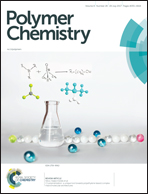Study of the RAFT homopolymerization and copolymerization of N-[3-(dimethylamino)propyl]methacrylamide hydrochloride and evaluation of the cytotoxicity of the resulting homo- and copolymers†
Abstract
The reversible addition–fragmentation chain transfer (RAFT) polymerization of N-[3-(dimethylamino)propyl]methacrylamide hydrochloride (DMAPMA·HCl) was studied. A detailed investigation of the effect of the polymerization conditions was carried out. The polymerization was conducted in a solvent mixture of water (acidic pH) and 2-propanol in the ratio of 2 : 1 using 4-cyanopentanoic acid dithiobenzoate (CTP) as the chain transfer agent (CTA), and 4,4′-azobis(4-cyanovaleric acid) (ACVA) as the initiator which was found to be the optimal condition to access well-defined homopolymers. The synthesis in acidic media and purification with precipitation in acetone allowed the good retention of dithioester chain end groups. The p(DMAPMA·HCl)-based macroCTA was prepared and successfully used in the diblock copolymerization of 2-lactobionamidoethyl methacrylamide (LAEMA), 2-aminoethyl methacrylamide hydrochloride (AEMA), N-(3-aminopropyl) morpholine methacrylamide (MPMA), and 2-methacryloyloxyethyl phosphorylcholine (MPC). Statistical DMAPMA·HCl-based copolymers of those monomers were also synthesized. Finally, the in vitro cytotoxicity of the resulting homo and copolymers of DMAPMA·HCl was investigated by the MTT assay in HeLa cells.
![Graphical abstract: Study of the RAFT homopolymerization and copolymerization of N-[3-(dimethylamino)propyl]methacrylamide hydrochloride and evaluation of the cytotoxicity of the resulting homo- and copolymers](/en/Image/Get?imageInfo.ImageType=GA&imageInfo.ImageIdentifier.ManuscriptID=C7PY00837F&imageInfo.ImageIdentifier.Year=2017)


 Please wait while we load your content...
Please wait while we load your content...